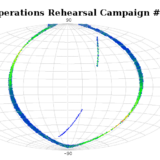Operations Rehearsal Campaign # 4
The fourth Gaia DPAC Operations Rehearsal campaign (also known as OR#4) took place during the last week of August and the first week of September. During 10 consecutive days (including the weekend in between), the most critical systems of DPAC were “rehearsed” by feeding about 10 days of mission data simulated with GASS (the Gaia telemetry simulator developed mainly at the UB), containing about 220 million observations of stars.
The main focus was on the “daily pipeline” of the Gaia Science Operations Centre (at ESAC, Madrid), where the following systems (among others) will be running continuously during the 5 years of the mission:
– MIT, receiving the data from the Mission Operations Centre (at ESOC, Darmstadt) and decompressing it.
– IDT (Initial Data Treatment), receiving the data from MIT and applying a series of complex algorithms in order to obtain, in near-realtime, the very first intermediate data products of the mission. That includes the position of the stars in the sky, their accurate position in the CCDs onboard, their brightness, their cross-match against an on-ground catalogue, etc. At the same time, it provides a quite exhaustive set of diagnostics. This system is coordinated by the UB, with the main developers and contributors also in the UB, plus ESAC, the UK, the Netherlands, Sweden, Italy…
– FL (First Look), doing a very exhaustive analysis and diagnostic of a representative fraction of the IDT results, in order to assess the correct operation of the spacecraft (and also of IDT), and at the same time determine a set of instrument calibrations for a more accurate processing.
These systems behaved mostly as expected during OR#4, just revealing minor problems that are being corrected these days. The large amount of data that was processed during OR#4 (some hundreds of GigaBytes) was also delivered to four other Data Processing Centres of DPAC: Toulouse, Cambridge, Torino and Barcelona. In our data processing centre (DPCB, in the Barcelona Supercomputing Centre premises) we correctly received and handled the 250GB (approx.) that we expected to receive during those days.
The image shows a skymap of some areas that were processed, which includes the last bits of the Commissioning period (the Ecliptic Pole seen by the two fields-of-view), plus the first day of Nominal operations (a few Great Circles close to the Galactic Plane).
We’re getting ready to crunch the first bytes of real data!






